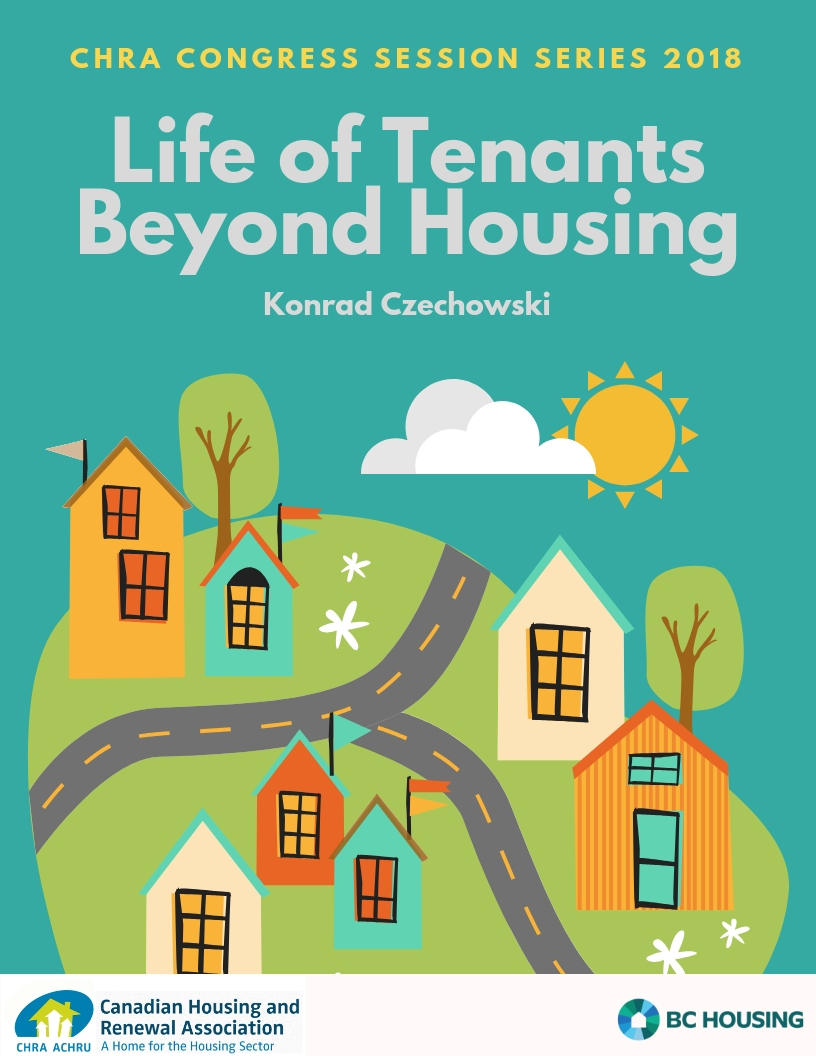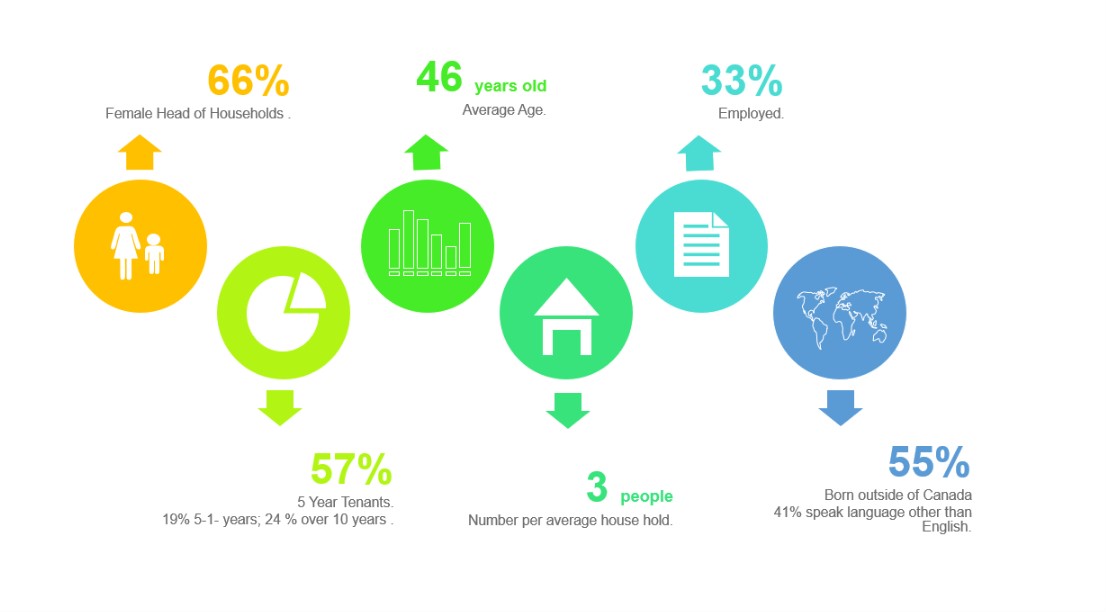 |
|---|
| Download the PDF version |
This is a summary of the workshop session ‘Life of Tenants Beyond Housing: Building Community’, which took place in Ottawa, on 25 April 2018 at the Canadian Housing and Renewal Association’s annual Congress on Housing and Homelessness.
A home is built on more than just housing. Connection to the community and a sense of belonging are important aspects of making a house a home. Capital Region Housing shared findings of their 2017 tenant wellbeing survey to better understand tenants and the challenges facing their households, extending their promise to tenants on helping find a way home and creating a holistic approach to customer relations. The Bloom Group shared their integrated approach to long-term tenancies, which includes housing services and supports that meet the immediate needs of individuals, while systematically building a foundation that strengthens community sustainability. Finally, Centre 454, Stella’s Place, and the Canadian Observatory on Homelessness offered perspectives on community integration and fostering a sense of belonging among tenants, including individuals leaving homelessness.
Summary authored by Konrad Czechowski, M.A. Experimental Psychology, Ph.D. Candidate Clinical Psychology, University of Ottawa
Panelists
Esther de Vos, Director of Policy, Research and Strategic Issues, Capital Region Housing (AB)
Karl Tegenfeldt, Manager, Affordable Housing Services, The Bloom Group (BC)
Munir Velji, Mental Health Housing Manager, The Bloom Group (BC)
Stephanie Rattelade, Research & Evaluation Manager, Stella’s Place (ON)
John Ecker, Director of Research and Evaluation, Canadian Observatory on Homelessness (ON)
Jen Crawford, Executive Director, Anglican Social Services-Centre 454 (ON)
Moderated by Christina Maes Nino, CHRA Regional Director, Manitoba and Executive Director,
Manitoba Non-Profit Housing Association (MNPHA)
Capital Region Housing Tenant Wellbeing Survey
Capital Region Housing (CRH) is a public body governed by the Alberta Housing Act based in Edmonton. Esther de Vos, CRH’s Director of Policy, Research and Strategic Issues presented findings from CRH’s tenant well-being survey 1. CRH view themselves as more than landlords and customer (tenant) service and satisfaction form a core part of their housing mandate. CRH wanted to study what their customers consider successful tenancy; effectively, other than subsidies, what do customers need to maximize their wellbeing?
The objective of the survey is to help inform CRH policy decisions and programs and supports. The survey was sent to all CRH tenants on file in May 2017 with a total of 465 responses received (about a 9% response rate). Figure 1 outlines the survey participant demographics.

Figure 1: survey participant demographics
Key Findings from the Survey
Financial Wellbeing. Despite receiving subsidies, some tenants reported feeling finance-related stress. For instance, 36% reported feeling high levels of finance or debt-related stress, and nearly half felt their current income did not meet their everyday needs.
Emotional Wellbeing. Although 69% reported being in good or very good mental health, 40% said they experienced a lot of stress.
Physical Wellbeing. The most common ways individuals accessed healthcare was through mediclinics (63%) and Primary Care Network (33%), and 90% of respondents had a family doctor.
Community Wellbeing. The majority of respondents liked that their community is close to schools, parks, transit, and grocery stores. Although as is apparent in Table 1, there were stark differences in perceptions based on immigration status.
| Foreign-Born | Canadian-Born | |
|---|---|---|
| Strong Sense of Belonging | 52% | 26% |
| Felt Safe in Community | 77% | 57% |
| Felt Safe at Home | 75% | 65% |
Table 1: Perceptions on community wellbeing
Survey participants indicated they would like greater access to recreation and organized sports, transit, and community events. Further, foreign-born respondents indicated they would like greater access to language and foreign credential recognition services.
Majority of surveyed tenants reported 70% or higher in life satisfaction (tenants were also asked to project their life satisfaction score for life in five years). Main barriers respondents described included health, employment and finances, and family pressures. Tenants born outside of Canada were more likely to report higher life satisfaction.
Most respondents who completed the survey reported they were satisfied with services offered by CRH (75% were happy or very happy to live in a CRH home). In continuing to engage with tenants and developing programs and supports to best meet tenant needs, CRH plans to undertake another survey in 2019.
From Housing to Homes: An Integrated Approach to Long-Term Tenancies
Karl Tegenfeldt and Munir Velji presented on the Bloom Group’s affordable housing and mental health supportive housing. The Bloom Group is a non-profit organisation based in Vancouver’s Downtown Eastside whose mission is to facilitate long-term tenancy for vulnerable community members, providing tenants with choice, dignity, and opportunities for community engagement.
The Bloom Group employs a person-centered model to tenancy that focuses on life stories and circumstances rather than illness. Using a case management approach to assess resident need, and a strengths-based practice with resident self-determination at its core, residents participate in goal setting which is reviewed on an annual basis.
A range of services are offered to residents, such as medical and mental health services, social activities, and art therapy. Additionally, all residents are offered three meals a day. The services and positive consistent interactions contribute to a sense of belonging and connectedness for residents. Importantly, there exists a special focus on ageing in place, where residents can remain housed in their current dwelling or community as they grow older without having to move out to access support services.
Affordable Housing
The affordable housing portfolio is the Bloom Group’s newest area of growth; out of their 350 units, 300 have been added since 2015. Focusing on balancing growth and sustainability, they have successfully created partnerships with other housing providers and local community-based organisations which allows the Bloom Group to provide residents with a wide range of services, such as budgeting for seniors.
However, even with positive partnership development, several challenges and lessons learned over time have been noted. Importance is placed on establishing and clarifying roles and responsibilities early on when forming partnerships. In striving to best meet resident needs and resisting the tendency to homogenize marginalized groups, the Bloom Group acknowledges that all groups have their own assets, challenges, obstacles, and resiliencies. Preconceived notions of who may require more or less support may not always prove to be accurate in reality. To that end, resident involvement and feedback ensures programs and supports meet evolving resident need.
Beyond Housing: Building Community and a Sense of Belonging for Individuals Leaving Homelessness
Social Support Experiences of Homeless and Vulnerably Housed Women
Dr. Stephanie Rattelade described findings from her doctoral dissertation 2 where she explored how social supports are experienced among homeless and vulnerably housed women and the important connection between social support and housing.
The dissertation compared the experiences of a sample of women who are vulnerably housed to a sample of women who are homeless, and found that despite actively seeking social support, both groups received insufficient levels of social support to address their needs.
Women who were homeless experienced a higher need for support than those who were vulnerably housed, and they also had a greater social network that often consisted of other individuals who were homeless. The group who were vulnerably housed reported higher feelings of isolation within their housing and participated less within their social networks. Women living in homeless shelters have more access to professional support, and informal supports like other individuals living in the shelter they could connect with.
The dissertation is important in highlighting opportunities to develop connections, particularly for those who are vulnerably housed, to decrease the levels of isolation felt and increasing social participation and connection.
A Mixed Methods Analysis of Community Integration Among Vulnerably Housed and Homeless Individuals
Dr. John Ecker also presented findings from his doctoral dissertation 3, which examined community integration – defined as a sense of belonging and membership to one’s community – among vulnerably housed and homeless individuals. The study looked at nearly 400 homeless and vulnerably housed individuals in Ottawa at two timepoints. The objective was to identify important factors in influencing psychological and social integration into participants’ communities.
The study found that individuals with established support networks found it easier to integrate into, interact with, and feel part of their neighbourhood. Older individuals were found to create more social bonds within their neighbourhoods, and satisfaction with housing quality and community activities underscored important factors that contributed to psychological integration.
In other words, when rehousing individuals, safe neighbourhoods and quality housing is likely to make it easier for individuals to integrate successfully into their communities. Dr. Ecker ended by concluding that “we can’t just house people, they have to be housed in good neighbourhoods.”
Day Programs and Building Community
Centre 454 provides support to people who are precariously housed or homeless in the Ottawa area. Executive Director Jen Crawford shared what has worked to successfully build community through the centre’s day programs. The centre’s purpose is to create a sense of belonging and build community for their service users, seeing 170-200 people daily. They provide a range of services and programs for their users, including counselling, assistance completing forms and applications for program supports and services, pre-employment skills training, and employment searching aid.
The community need for the Centre and its purpose were exemplified by a client who commented that, “I finally got on [disability support], got my apartment on the top floor, even has a fireplace, but when I’m there alone for too long I feel so isolated.”
Programs such as Housing First fill an important need by successfully helping to house individuals, but services such as the ones offered by Centre 454 provide a space for individuals to socialize and build community. The quoted individual drops by the centre daily, takes part in their programs, and gives back by helping out around the centre.
The centre’s goal is not to move or graduate people from their program, but to build lasting connections, to have individuals continue to come back for years, ultimately creating sense of community and belonging.
In Summary
The Canadian Housing and Renewal Association’s Congress 2018 workshop ‘Life of Tenants Beyond Housing: Building Community’ drew on both research findings and examples of successful community-building approaches to examine and illustrate how sense of belonging among community members can be fostered.
Research findings presented on exiting homelessness toward community integration highlighted the need for ongoing support though social networks, namely opportunities to develop connection. This is particularly important once individuals are housed and experience less opportunities for social interaction than when they were homeless. This need for positive interaction was echoed by a tenant wellbeing survey commissioned by Capital Region Housing illustrating that successful tenancy requires more than simply meeting basic financial needs, such as subsidies, but also requires meeting emotional, physical, and community needs. An overview of Ottawa’s Centre 454-day programs showed how community can be built successfully in creating a space where community members can meet regularly to socialize, interact, and cooperate in meaningful activities.
Endnotes
1. Capital Region Housing produced an infographic outlining the report’s findings in addition to a detailed final report, which can be found here.
2. Stephanie Anne Rattelade. The Exploration of Social Support and Social Networks in Homeless and Vulnerably-Housed Women. University of Ottawa (2016).
3. John Ecker. A Mixed Methods Analysis of Community Integration Among Vulnerably Housed and Homeless Individuals. University of Ottawa (2015).
